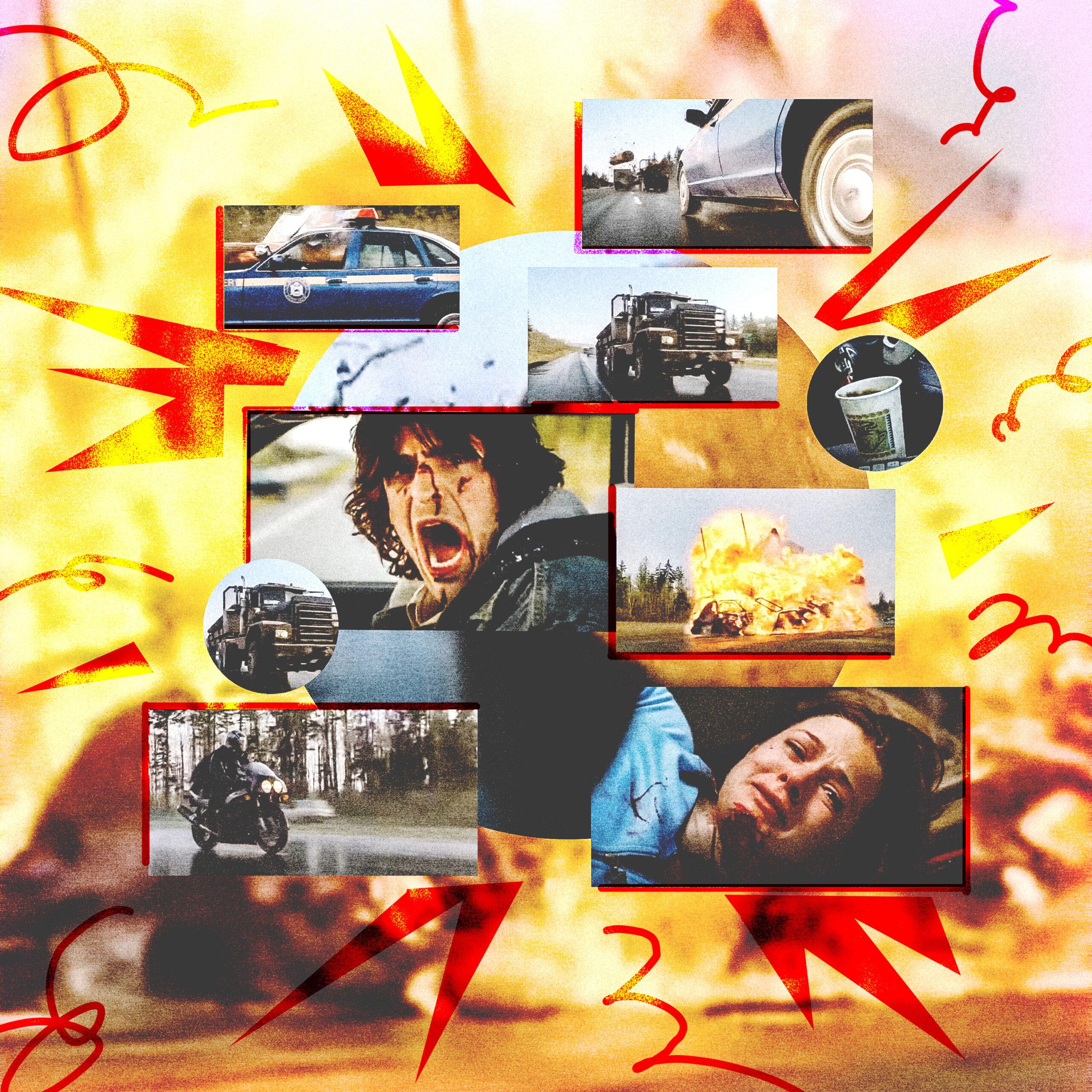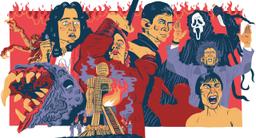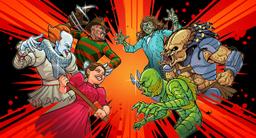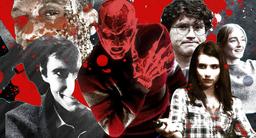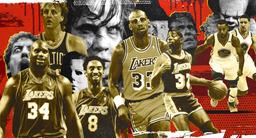The Oral History of the ‘Final Destination 2’ Log Truck Sequence
If you’re of a certain age, you probably drive by semitrucks on the highway as quickly as possible. Here’s the story behind the reason for that.Jeffrey Reddick needed something flashier. In the spring of 2000, the Final Destination writer had sketched out a 10-page treatment for a sequel to the surprise hit horror film about a bunch of teenagers who narrowly avoid a mass-casualty plane crash and get hunted down by death. The only thing missing? An opening set piece that would up the jet-fueled terror of its predecessor and kill a bunch of high school protagonists in an unthinkably gruesome way.
At first, Reddick had thought about frying them up in a hotel fire, but he and producer Craig Perry knew they could do better. “Once you realize what the formula for this franchise is, the opening scene is obviously quite critical,” Perry says.
“That opening was eating at me,” Reddick adds.
Then, on a trip home to Kentucky to see his mother and sister, inspiration struck. After leaving the airport, Reddick merged his rental car onto the Mountain Parkway and soon found himself behind a log truck. The 30-year-old writer was already freaked out—he’d spent most of his post-collegiate life in New York City, rarely behind the wheel. But he started to speed up. “I pulled into the next lane to drive past the truck, and I was kind of nervous,” he says. “And then I was like, ‘Wait a minute, this is it! I think this is the opening.’” Reddick quickly pulled off the road and called Perry.
“You try to think of things that everyday people can relate to,” Reddick says. “I think that’s probably why it clicked so quickly—because I’m driving on high alert and hating it. You never know what other drivers are going to do.”
Less than three years later, stunt veteran and director David R. Ellis, who died in 2013, took that vision of highway anxiety and amplified it to a traumatic degree. While waiting to merge onto Route 23 with her three friends, Kimberly (A.J. Cook) has a premonition of a deadly pileup started by a logging truck. After the trailer’s straps break, numerous tree trunks drop onto the slick pavement, setting off a bloody and fiery game of dominoes—logs slam through windshields, SUVs flip over, garbage trucks bulldoze cars, and gas explosions smoke up the sky. It’s a visceral, high-speed, absurdist cascade of carnage against a soundtrack of melting rubber, shattered glass, and high-decibel screams. As a car carrier barrels toward her, Kimberly snaps out of her vision, regains her faculties, and realizes the fate that awaits her.
From one angle, the start of Final Destination 2 plays like a hellish fever dream—a twisted dance with no survivors and a continuation of the first movie’s haunting self-seriousness. But viewed through a slightly different lens, the highway death trap is something closer to slapstick tragedy—a Rube Goldberg machine of doom operating with the kind of winking, wicked glee that Eric Bress and J. Mackye Gruber, the screenwriters who’d go on to adapt Reddick’s treatment, felt a sequel deserved. To this day, it’s still the franchise’s crowning achievement, the kind of practical, devilishly creative, horrifyingly violent sequence that still comes to the mind of anyone who’s seen the movie and later found themselves on the highway behind a truck loaded with cargo. “Part of the fun of working on the franchise is coming up with those deceptively simple events or elements that everybody encounters and then finding that really evil way of injecting a little malevolence into them,” Perry says. “It’s delicious. It’s so much fun.”
Part 1: “The Carnage Is Immeasurable”
After a $10 million opening weekend in 2000, Final Destination held strong at the box office and slowly developed a fan base. Over its six-month run, the movie—made up of a young and largely unrecognized cast and an invisible villain—earned $113 million globally, prompting New Line Cinema executives to consider its franchise potential.
Craig Perry (producer): Once the international numbers started coming in, they were like, “We might have a market here.” That’s when we really started to look at doing a sequel.
Jeffrey Reddick (executive producer): By the second week, I already knew that they were going to green-light a sequel. I got with Craig again, and we started working on a story. At that time, I was still a newbie screenwriter and worked at [New Line]. They were finally like, “Jeffrey, you’re a real writer now. It’s time to leave the nest.” I didn’t quit until after I sold the treatment. So they basically went out to a lot of the big horror writers with my treatment.
Perry: We got a lot of drafts.
J. Mackye Gruber (writer): Eric Bress and I had written the screenplay for [The Butterfly Effect]; it was titled Blackouts at that time. We got a huge response that everybody wanted to meet us, but they felt like it was really dark and really complex. No one really had the balls to just go for it. Then this writing job came up at New Line. [Executive producer] Richard Brener was a fan of the Blackouts script and just said, “Maybe the guys should come in here and give us a pitch for Final Destination 2.”
Eric Bress (writer): We were told it had to have a log truck pileup in the beginning. That was the only rule that we were given. So we didn’t go color outside of the lines too far and come up with a completely different set piece opener.
Gruber: Eric and I hadn’t seen the first one at that time, but we found one theater in Orange County to go check it out. When we got out, we were like, “That’s different. That’s cool. We’re into this.” And then we just started coming up with our idea. You’re like, “How can you make the second one different enough?”
Bress: We didn’t want just a bunch of teenagers. We wanted adults and kids. We wanted to tell a story where all people are represented.
Reddick: That was very intentional. You thought Kimberly and her friends were going to be the leads—and then you kill the teenagers off and bring the adults in.
Getting the order was the hardest thing. We got it right up to: “The log falls off the truck and bounces toward the police car.” And then we wrote four words: “The carnage is immeasurable.”Eric Bress
Perry: Jeffrey wrote his treatment. Jon [J. Mackye Gruber] and Eric wrote their treatment. And they each had things that we liked from the other. So we said, “Guys, we want to sort of blend them together.” But we were leaning more toward the overall story that Jon and Eric came up with, with a smattering of really interesting and fun ideas that Jeffrey had posited. So it was a synthesis, but it was more like 75/25.
Reddick: My treatment wasn’t super dark—it just didn’t have that fun or the crazy kill scenes that they brought to it.
Gruber: We thought, if you have a mother who’s trying to protect her kid, and you’re on a [death] list, well, that’s a really interesting dynamic right there.
Bress: In the first draft, that kid was like 7 years old instead of a 16-year-old, because that’s really horrific. And then we’d start laughing about how horrible it was, and we’d get really married to it until somebody with a better sense of reason would come along: “Guys, no!”
Gruber: We sent off some scenes just to show Craig Perry the tone we were going for. And he was like, “You can’t be serious. What are you doing here? The kid is really young.” We were maybe pushing some of the comedy a little far.
Perry: I do think that by just opening that tonal aperture, you kind of allow the audience to have a little more fun with it. It’s a challenge, but I think 2 really does marry cringe and anxiety and tension with that sense of humor. It provided us with a better template going forward.
Bress: We had set up every single character and what was going to cause an accident for them—the bottle rolling under the brake pedal and the spilled coffee. Those were things that we all do every day. Getting the order was the hardest thing. We got it right up to: “The log falls off the truck and bounces toward the police car.” And then we wrote four words: “The carnage is immeasurable.” That was our contribution to the genius that followed.
Reddick: When we hired David Ellis, we just knew we didn’t have to spell it out. David could make this more spectacular than anything.
Perry: When you go to somebody who wants to be a director and say, “Hey, how about Final Destination 2?” they’re like, “Really? Is that what I want to do?” But if you make this overture to someone who has been doing high-end second-unit directing work his whole life but has never had the chance to direct a feature on his own, that’s not a step down. That’s an opportunity.
Gruber: We’re like, “We’re in good hands. He knows how they’re going to die.”
Part 2: “There Is a Logic That You Need to Follow”
The opening sequence of a Final Destination movie has to operate like a third-act climax and establish death’s intricate design. Nobody was better suited to orchestrate the madness than Ellis, whose second-unit directing work on Waterworld, The Perfect Storm, and The Matrix Reloaded had established him as an instinctual filmmaker and innate leader.
Justis Greene (coproducer, unit production manager): At the time, David Ellis and Vic Armstrong were the two highest-paid second-unit directors in the world and both famous for doing the impossible—putting together action sequences and capturing them in camera without visual effects. That’s very much what the log sequence in Final Destination 2 is. A real logging truck and real logs and real cars and real people.
Freddie Hice (stunt coordinator): [David and I] had just done Matrix Reloaded together, and the car sequence in that was just ridiculous. So when we got to this, we thought, “Oh, this is gonna be easy.” Well, it wasn't easy. It was pretty radical. I don’t even think we had the money for that type of CGI work. We had to try and do as much of it real as we possibly could.
Gary Capo (director of photography): I don’t think there was ever any intent of doing any of it computer generated. You see so many Fast & Furious movies with so much CGI. It just doesn’t have the same feel.
Hice: We went over to Vancouver Island, which is a logging island. The main thing was to find roads long enough where David could have the camera vehicles following the logging truck and the cop car and the vehicles, with plenty of room to shoot and get all that circus turned around.
Greene: That highway cut through a First Nations community. It had just opened that year. It was not only the economic driver of Vancouver Island, but it was actually a huge political situation. In British Columbia, you needed the blessing of the First Nations community to be there. But David charmed his way through those meetings, and we went away with permission to do it.
Perry: The whole highway looked basically the same. It was in a wooded area. There were not many creeks, so you didn’t have any continuity issues.
Capo: We made the decision to wet the roads because we were going to take like two weeks to do the whole sequence with the dialogue and everything. And we knew that in Vancouver, it was going to rain at least a few of those days. We wet down the roads every day. We never saw a cloud for two weeks.
Greene: We didn’t do anything arbitrarily. We had the best drivers. We had the best effects people. And it wasn’t that we had the largest budget. It was the way David treated people. And then he would go to his team—to Gary, to [second-unit director] Dave Barrett, to Freddie Hice and [special effects coordinator] Alex Burdett—and talk about how we could do it.
Hice: He always had this camera box, and inside would be every kind of toy car, truck, motorcycle. He was one of the first stunt coordinators that used the Mattel Hot Wheels.
Greene: That’s sort of a joke among crew and production people—you can always tell a stunt coordinator because they walk around with Matchbox cars in their pockets. David wasn’t familiar with how logging trucks worked, but he just visualized the sequence.
Perry: The amount of time that we all spent with little Matchbox cars, figuring out where everyone was going to be and the exact order of the cars …
Capo: We had this 2-mile stretch of road, and we just picked spots where different events would happen and decided where we were going to put the cameras and how it was going to be covered—what was going to happen with each car, whether it was going to be one that rolled or flipped or crashed.
Perry: You’ll notice, and this is a credit to David, that right before the coffee spill, there’s a wide shot where you can literally see everybody in the lineup and how they’ve all moved around to get into that final position. That was not happenstance. That was incredibly orchestrated. Because it needed to be. There is a logic that you need to follow.
Gruber: This was just when the “Russian Arm” got invented. It’s a techno crane on top of a car, so it goes 360 degrees. And David was so excited—just the idea that you could flip the car over and around. He was just thinking, “What are all the ways I could do it?”
Alex Burdett (special effects coordinator): Once that was sort of mapped out on a table, we would get like-type vehicles and do some tests for David and adjust—a little more, a little less, break it here and not there—and manufacture the final product that way.
Hice: By the time we got there, we would chalk out the highway. We’d take every one of the drivers that was involved in the sequence. I’d say, “OK, Tommy [Glass], you’re the logging truck. Trish [Schill], you’re three cars back …” Everybody that’s actually driving was looking at the miniature version of what we were going to do.
Capo: You always want the action to come toward the camera. Obviously, there’s no continuous action. Each [stunt] is a separate piece. So when something rolls and flips or spins around, you sort of just decide what’s the best way to do it. You typically storyboard so you know what you’re going for.
Hice: Between David and his storyboard guy, we’d start dreaming up the shots. We went out and made sure he loved the storyboards. He would put them on a great big board every day by the camera so everybody could see what we were going to shoot. There were no surprises. And then we would go and get in the cars and do 5-10-mile-per-hour rehearsals—go a little quicker, a little quicker, and never do it at the speed, but pretty close. I don’t even think we had a week of rehearsals.
Greene: In his normal manner, David had done his storyboards and had done his planning so well. He would have that way of swiveling his head as he walked toward the issue. And by the time he got to the issue, he had a solution. I wasn’t nervous at all that David’s expectations weren’t going to be met.
Gruber: This was his directorial debut. I think he just wanted to pull everything out of his bag of tricks and show everybody what he’s got.
Part 3: “One of Those Logs Would Weigh 4,000 Freaking Pounds”
Shooting on the highway took place near Campbell River during the final weeks of production in spring of 2002. The primary order of business? Getting tons of timber to perform properly.
Greene: No one had ever done the logging gag. Each log is a different size and is a different kind of bark and has a different way of adhering to the other log and the different places where the branches have come off. They don’t react like a load of telephone poles.
Joe Bauer (visual effects supervisor): The intention was to set the logs on the truck, get all of that traffic going, and then pull off each of the stunts—and then the equipment would come back in, load the logs back onto the truck, everybody resets. But the logs almost never behaved as one would have hoped.
Greene: We did try to build logs that we could control. And, of course, they looked like crap. So David decided that it was best to work with real logs.
Capo: The special effects department had prepped a truck full of logs with a little explosive device on the cables that was meant to go off, and then the logs were going to fall off of the moving truck. We tried filming that like three times. Each time, the cables would blow, and then the logs wouldn't go anywhere.
Bauer: They just sat there stuck together.
Hice: Tommy Glass was one of the greatest Canadian stuntmen of all time. Truck driver extraordinaire. Tommy had a presence of mind to jerk the steering wheel of that truck back and forth, and he shook those logs off. And it worked; I couldn't believe it.
Burdett: We initially did a test with real logs, and it was determined that we could get that shot—the breaking of the chains—but nothing else. The logs are so heavy you can’t control the bounce and where they’re going to go.
Guy Bews (stunt driver): One of those logs would weigh 4,000 freaking pounds or more. It’s crazy.
Perry: They hit the ground. They don’t bounce big. They kind of slide off and then kind of roll away, fanning out. When some of them did come off, you’re like, “Hmm, that’s a little underwhelming.”
It was like summer camp with fireballs.Craig Perry
Greene: At that point, you’ve got between 150 and 250 people on that controlled set. You’re burning money. And you’re burning daylight because that shot has to tie in light-wise to the shot prior to it.
Bauer: I won’t say I anticipated it, but I thought, “It would be a smart idea to start working on CG heavy-log dynamics in prep.” There was a company that I liked in Burbank called Digital Dimension—a handful of guys. We had done a bunch of tests. And when David started running into these fails for manipulating the logs and long resets, I showed him some of the dynamics tests that we had done. He looked at me, and he said, “I don’t need to shoot logs anymore, do I?” So we inherited all of that work.
Perry: I give all credit to Joe Bauer for just saying, “Let’s just do a pass that has a flatbed, I’ll get some trackers on there, and I’ll put logs on there.” And at that point, when you’re running out of time and daylight and money, you just trust in the people who say, “I’ve got this.”
Greene: Alex and his group tested and tested, and were able to show [Joe] what the logs would and wouldn’t do. And that allowed the VFX guys to know what they had to enhance.
Bauer: It’s getting the weights right. It’s getting all the debris that comes off and then selling the appropriate amount of weight. The simulation guys would show me where it would actually bounce based on how big and heavy it was. I was always nudging it higher, higher, higher because it looked more exciting.
Perry: About 30 percent of the logs are actually real. Everything else is what Joe added to the equation.
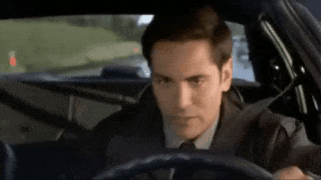
Bauer: There's a very over-cranked shot of the first log coming off the pile and hitting the freeway and the debris exploding and it reflecting in the wetness of the road. I thought that was a really pretty shot—and it had a lot of power to it. And then they put a great sound on it.
Scott Gershin (sound designer): It’s almost a little bit of a slow-motion warped sound, where it’s like, “Uh-oh, here we go.” I know we hint at the chain. Is it coming loose? Do we hear a creak of the wood? It’s using sound to psychologically mess with the audience.
Perry: We wanted to make it both kinetic and cinematic to really sell the impact.
Burdett: For the police car decapitation, we rented a large feller buncher. Basically, it’s got a large claw on the end of it, and it held the log in place. And then we towed the car into the log. That was all practical.
Bauer: They had the log in a fixed position with the dummy in the driver’s seat and blood bags and all that stuff.
Hice: There was a line that’s attached from the front of the car to the back of the truck where the logs are. They did a little green screen behind it so they could add in motion with that dummy in there. However they put it together, it looks like the log is coming through the window.
Michael Landes (Officer Thomas Burke): They do a mold of your face in Burbank. You sit for three hours, and then they put that mask in the cop car on a dummy. But they filled the entire head with blood. I thought they put too much blood in the face. I was like, “It looks more like Stallone than Michael Landes.”
Burdett: The person who did the prosthetics was Bill Terezakis, who unfortunately passed away about four years ago. He did molds of all the actors and built the dummies. A lot of their latex is very strong and elastic and hard to blow up because it has a lot of give to it. We did some tests to make sure the head would blow up with the blood.
Perry: There was a bit where the log comes off and you see it bounce into the white van as it goes by. David just added the dent on the side. We didn’t have the budget for it, but he said, “How can I help make it feel like there’s impact and weight behind these things?” That attention to detail elevated the sequence. You don’t notice it, but you feel it.
Part 4: “David Just Liked to Blow Shit Up”
After a log smashes through Officer Burke’s police car, a calamitous chain of events unfolds: A motorcyclist falls and gets crushed by his own bike, a trash truck slams through a druggie’s blue Mustang, Kimberly’s red SUV flips and rolls numerous times, and a car carrier rams through a flaming convertible. To pull it off, Ellis relied on a handful of veteran stunt performers he had met throughout his career.
Ernest Jackson (stunt motorcyclist): I raced a little motocross and learned how to ride a bit. I just so happened to get the call—the first thing they said: “Do you have a problem with dropping off your motorcycle at 50 miles an hour?” About three months before that, I went down on my Harley and almost got run over by a semi. That was a big deal. I’m like, “I don't know, man …” [Scott Nicholson] goes, “Oh, you’ve done it once. You can do it again.”
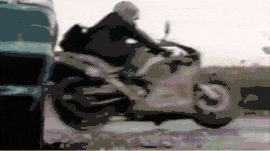
Hice: It’s what we call the typical motorcycle wreck. He comes in and lays it down all practical, slides it out, and gets turned around.
Jackson: I started rehearsing it on my own time. David wanted me to hit the log first, and the bike would come in and hit me after. We thought we were going to do this in a couple pieces, but with the momentum that I had when I dropped the bike, that piece of the puzzle got done automatically. The way I let it go, it ended up going behind me.
Hice: It wasn’t hard for us to slide him across that pavement. He was on racing leathers. We did do one shot with Ernie and the bike on the same cable getting pulled. Then we put a dummy in and slid the bike into the dummy. We couldn’t have done it with Ernie. We would have killed him.
Burdett: That was a motorcycle hitting a real log.
Jackson: We had padded the log. I might have slid maybe 20 feet at that point for that last bit of impact.
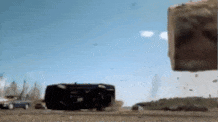
Jonathan Cherry (Rory): There was a very happy accident that happened with my Mustang. It was not supposed to go that far. The whole thing was just epic. I had no idea how big they were going to go with it.
Scott Nicholson (Canadian stunt coordinator): I actually flipped right over top of one of the cameras, which is a great shot.
Capo: We got lucky with a lot of camera placements.
Nicholson: When you do cannon [rolls] and you stay on the asphalt, it’s more consistent. There’s not a precise area where you’re going to land. And so I ended up tumbling down the highway seven times.
Hice: Scott had never done a [cannon roll], but I told him how to do it, and he did an incredible job.
Nicholson: I brought my own race-car seat, a five-point seat belt, and a helmet. We were kind of old-school. I would make shoulder straps with D rings on my helmet to keep your neck in place. In this day and age, everybody wears a HANS device, which the NASCAR and Formula One drivers wear. You want to make sure that you don’t hold on to that steering wheel. If the wheel gets hit, it’ll snap your arm.
Bews: We got all that done, and then I drove the garbage truck that smashes the stoner kid’s Mustang in half and blows it up. We just went through all the beats. Mine was pretty simple: Make sure you hit that effing car hard and blow it up everywhere. Which we did.
Cherry: I had no idea the size of the truck that was going to smash me or anything like that. They were just like, “Truck’s coming at you—scream.”
Capo: There’s a lot of cuts to the actors right before their death.
Cherry: And that’s like the first big fireball moment. It’s so unrealistic in some ways, but it makes the drama so much better.
Hice: When the trash truck hit all that shit, the cars didn’t have motors in them. They’re shells. And if I remember right, there were bombs in the cars that the truck hit too as the fireballs went off. It just blows everything up.
Bews: I put on some fireproof underwear, just in case a little bit of fire somehow found its way into that cab. Otherwise, we knew we were OK. It was a smooth and clean [hit]. It almost disintegrates it in that 50-60-mile-per-hour zone.
David Jacox (stunt driver): When they pay us to go and wreck other people’s shit, that’s the best thing in the world.
Hice: Those fire bombs are huge, but you’ve got all the fire safety guys outside.
Burdett: We had a six-man pyro crew on that. There were a few things that we did on the fly while we were out on the highway. A couple of the explosions were supposed to be just crashes. And then David said, “Oh, I think I’d like to see that blow up now.”
Hice: David just liked to blow shit up. When something wasn't going to be great, he’d add a fireball to it.
Perry: We were off on the island; no one’s paying attention to us. It was like summer camp with fireballs.
Bauer: Everything that was done on set was really impressive, but sometimes it just didn’t last long enough. We ended up enhancing a lot of the fire.
Nicholson: Every day we had a different scenario—a different guy in a different vehicle.
Perry: Up at the top of the hill, there was a little turnaround. So on one side, we did the hundred picture cars and all the dialogue stuff going round and round and round. The Valley of Death is what we called where we did all the crashes and the stunts. So while we were over here doing all the dialogue, they’d be setting things up down there to do the gag.
Landes: The second-unit guys would go like 2 miles up the road, do all the stunt shit, and drive back and show David the footage.
Perry: It was very well organized by Justis Greene. He understood how to map out the most efficient and cost-effective way to capture it, in the most spectacular way as well.
Bauer: There was always that terrible moment after the stunt. The car is completely demolished, and you know there’s a person in there. And then Freddie and the other stunt people go and check it. You’re just like, “Oh my God, I hope everybody’s OK.” You get the thumbs up, and everybody cheers. We just did that over and over again.
Nicholson: We have lost a lot of work to visual effects, but the practicality of it is where the money is, and they still need that—you can’t replace us with a robot.
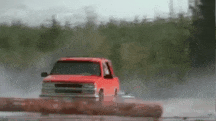
The most challenging stunt involved Kimberly’s red Chevy Tahoe, which needed to hit an errant log from the side, flip over it, and roll down the highway. Similar to the blue Mustang stunt, Hice assembled the SUV with an air cannon to initiate its roll.
Jacox: Melissa Stubbs did one first. When she did the roll, it was just her in the car. And it didn’t really look the way they wanted it to look. Then I did one. That was my first-ever cannon roll in a vehicle. I remember saying to Scott, “When it’s all over, I’m going to be unconscious. And I’m going to peek my eyes open, and if you give me the thumbs up, I’ll wake up, and it’ll be fine. And if you don’t, then I’m going to stay unconscious and go to the hospital.” I just knew how important it was to get it done right.
Hice: We wedged him in there, strapped him with his belt, and put his helmet on. I said, “You’re the best girl in Canada.” He came in and saved the day.
Jacox: When you see the girl with the hair coming out of the car—that was all dummies. It was a beautiful thing. It’s all slo-mo, and the hair is coming out of the sunroof.
Hice: The hair is just, like, flowing out. I left the sunroof open, and the dummies were not strapped in like a guy would be strapped in. You’re hoping that you get something like that. And that’s what happened!
Burdett: That’s just the film fairies. They’re helping you out. But that’s a testament also to making sure that your dummies look like real people.
Perry: Abject serendipity. The luck of the draw. And the arm! You say, “Wait, is that a human arm?” Your brain informs things like that. You’re like, “Oh my God, that’s [Kimberly’s] friend!” You recognize that person, and then it’s gone, and you’re now fueling that image of that person that we’ve spent some time with in that wider shot of the car flipping and rolling. There’s so much interesting psychology that you have to consider going into these things.
Reddick: That’s my favorite fucking shot.
Hice: They wanted the momentum to build. As the crash had started, they would just get bigger, bigger, bigger until they were just ridiculous.

Bauer: The most involved is when the car-carrying semitruck comes sliding through the fire at the camera and wipes out our guy in the red convertible. That was a big miniature that we shot at a miniature shop. We did a number of takes. The car carrier had miniature cars on it. Everything jostled and behaved realistically. That was a lot of fun to shoot, and honestly, it dropped right in. We had layers of fire elements that we could stack in front of and around the actor in the convertible to make his situation look much worse.
Burdett: That was a combination of two shots. [On the highway], we filled a bunch of water bottles with gas, all dangling underneath the truck. And that’s your initial source. And then we laid steel plates on the highway and fed liquid propane to create the wall of fire that he drives through.
Hice: You have to have all the fire marshals out there. You have to forewarn anybody that lives in wherever they determine the radius. They also ran that thing on the local radio all the time, saying, “They’re out shooting on the highway.”
Perry: We’d already done the explosion, and we’re like, “That’s a big-ass explosion. We better make that gas tank a little bigger.”
Hice: After all this fire and smoke, the idea that a truck would still be going 60 miles an hour right through something is a little obnoxious, but it seems like there’s something else at play. That death is coming.
Gershin: We wanted things to have a personality, so the truck becomes sort of a beast and a creature without it roaring and sounding like a lion or anything. The audience knows the setup, so now we’re trying to use audio as almost a conversation, as almost a dialogue.
Perry: It’s kind of divorced from physics. And it goes to one of the sort of bedrock principles for doing any of these movies. Is the action plausible and credible? Is it just enough that you think, “Yeah, that could happen”? That’s all you need. Because these movies are about the million-in-one shot that something’s going to happen. Final Destination lives in that 1 percent that it might happen. If we can make you believe that it could work, we’ve got you.
Bauer: If you set it up right, the audience goes, “Yeah!” If you’re lucky and you do it well enough, the audience is very happy to go along for that amusement park ride.
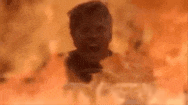
Perry: Ultimately, you sort of map out the arc of intensity of the sequence, right? We wanted you and the audience and [Kimberly] to feel like the sequence was over. “Oh my God, she landed, car’s on its side.” But we pushed through the smoke. We see her while she’s alive—one of her friends is moving. Maybe they’re not all dead. And then we see what she sees, which is David’s character getting burned to a crisp, and you’re like, “That’s so horrible, but what else could possibly go wrong?”
Landes: Her lying there in the SUV is the best shot. One of the trucks just coming at her, and she’s still alive—and then it flashes back.
Perry: Then you do the coup de grâce to get us into the transition that we want—eye to eye. That is all mapped out in advance because that’s just sort of the push and pull of creatively ratcheting a sequence up so that you’re toying with the audience, the expectation, and their engagement. That is very specifically calibrated.
Capo: My favorite shot is at the very end, the last shot of the car crash, when the semi smashes into the red car and pushes it down the highway.
Bress: I remember that was part of the fun. “We have an opportunity to really throw the audience and smack them twice.” The people that you believe are your main characters, that we’re going to be with for the whole rest of the movie—like Janet Leigh in Psycho—that’s not the movie. When you start seeing close-ups of these other highway-goers, it’s like, “Oh, I got it. This is going to be their story.”
Part 5: “Everything Has the Potential to Kill You”
Though the sequel didn’t outperform the original at the box office, it effectively established the tonal blueprint for the rest of the series. In the decades since its release, the log truck has remained the franchise’s iconic totem, a reminder of the highway’s disaster potential and a recurring meme that even made its way into the trailer and marketing for Final Destination Bloodlines.
Perry: When we did the first preview, it was everything you would imagine. At that point, the visual effects were sort of as rudimentary as you would expect them to be, but because most of it was practical, they sold the visceral quality of it. We knew that we had them.
Gruber: The test screening was so good and so fun. It was one of the best experiences of my life because it was just filled with all the right people, and they all laughed at all the right moments.
Bress: It was electric—and it all started with the highway sequence. That got them frothing. And then every other scene that followed was like a piece of cake, and they’re going crazy.
Cherry: My parents flew in to the premiere at the ArcLight. The first time I did a [coke] bump, my Jewish mom had the audience going. It was pretty funny. She doesn’t watch that kind of shit. There was a lot of nervous laughter because you kind of knew—the baby hitting the toy trucks together. Like, it was tense. And then I get hit by the car, and she’s literally having a heart attack. And she was so vocal. She was, like, conducting the audience. They were waiting for her reaction. There was a round of applause after that. It was a magical night.
Reddick: People were thunderously cheering. At the end of the premonition, it was like, WHOA.
Bress: I remember opening day. I was at Universal CityWalk, and I think theaters four and seven are the giant theaters. I’m in number four, and the movie ends, and the credits roll, and I follow the crowd out—and they all go into theater seven. It’s about 20 minutes into the film, and like 20 or 30 people just went right out of that into seeing it again, which blew my mind.
Hice: I’ve done a number of pictures with Quentin Tarantino. I first met him when I was the co–stunt coordinator on Django. And he comes up to me, and he goes, “Hey, you were the stunt coordinator on Final Destination 2?” And I go, “Yeah.” He goes, “Well, you’re a fucking cowboy.”
Landes: The fact that David was in charge of this sequence—you almost couldn’t have asked for anybody better. And he wanted to flex. This is a guy that’s worked his whole life doing this stuff. He’s like, “Now I’m in charge, and I can bring out all my buddies, and I can do everything I ever wanted to do because it’s my movie.” It gave it that extra magic that maybe wouldn’t happen had they not had him.
Greene: There’d be 300 people working and vehicles everywhere and preparation and effects guys and pyro guys and all this stuff going on. He had the ability to take it all in.
Bauer: It really is a symphony of chaos. There’s so many elements to play with, to set up and deliver. And that’s really what you’re doing again and again in a sequence like that: You’re setting up, and then you’re delivering.
Capo: Like the woman and her son, when she actually steps on the water bottle, right? You have to get that kind of shot.
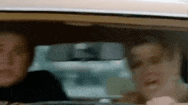
Landes: I think it put a lot of fear in people. I’m so aware of what’s around my brake and gas when I drive. I’ll speed around a truck. It’s made me conscious!
Jackson: When I ride my motorcycle, I always pass trucks. I never ride in that zone, no matter what kind of truck it is.
Bauer: The whole Final Destination franchise is all about your Spidey sense saying, “Something could go wrong here.” And then it does.
Perry: You drive behind a plumber’s van, you see PVC pipe on top, you’re like, “Bad things are about to happen.” It’s one of the most crystallized times where you understand how the franchise works—that simple, identifiable moment that everybody has found themselves in. “Wow, there's a lot of chains there,” and your mind immediately goes to Final Destination. It’s a terrible way to live my life. I walk into every room, and I do a threat matrix.
Hice: I mean, all those Final Destination movies were meant to just freak you out a little bit. Everything has the potential to kill you, basically. And who’s to say it couldn't happen?
Bress: Memories are stored with emotion. By the time the tension has magnified to its critical mass, the accidents happen, starting with the log truck. I think that gets embedded in your long-term memory—like it was a personal, visceral experience. That’s why on a physiological, psychological level, it hits a lot more than even the plane crash. My hat’s off to the first movie, but I don’t think you’re as emotionally on edge.
Bauer: I still get people that I don’t even know sending me images of the back of a log truck.
Perry: When people get behind a log truck, the first thing they do is take a picture or a video of it and say, “Not today, Satan,” and they post it online. We were very fortunate that the advent of social media allowed us to become a meme. It allowed it to become a hashtag. So now, every day I get four or five new ones.
Bauer: It’s a miracle that that sequence doesn’t happen every day.
Gruber: I think that once you tune your brain to that, you’ll see [death] all over the place.
Interviews have been edited and condensed.
